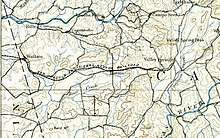San Joaquin and Sierra Nevada Railroad
The San Joaquin and Sierra Nevada Railroad (or Rail Road) was originally built as a 3 ft (914 mm) narrow gauge that ran from Bracks Landing (10.6 miles west of Woodbridge on the San Joaquin Delta, on the Brack Tract on the east side of South Mokelumne River, between Hog Slough and Terminous) to Woodbridge and Lodi and then east to the Sierra Nevada foothill town of Valley Springs. The railroad was incorporated on March 28, 1882 and construction was completed on April 15, 1885. The railroad was built as a common carrier with copper mining being its primary traffic. The track was built using 35/40 lb steel rails.
| Overview | |
|---|---|
| Headquarters | San Francisco, California |
| Locale | Lodi, California area |
| Dates of operation | 1882–1888 |
| Technical | |
| Track gauge | 3 ft (914 mm) narrow gauge |
On March 15, 1888 the San Joaquin & Sierra Nevada was consolidated into Southern Pacific Railroad's (SP) subsidiary, the Northern Railway Company. In 1897, the Northern Railway abandoned the track between Woodbridge and Brack's Landing and converted the rest of the line to 4 ft 8 1⁄2 in (1,435 mm) standard gauge. The following year, the Northern Railway was consolidated into the Southern Pacific.
In 1925/1926, Southern Pacific extended the branch line 8 miles east into the Sierras to its ending point known as Kentucky House (or Kentucky Home). The last 4 miles of the branch at Kentucky House were sold to the Calaveras Cement Company on April 28, 1929. The Calaveras Cement Company closed the plant at Kentucky House in 1984. Prior to 1984, the SP was operating three freight trains per week between Lodi and Kentucky House. The branch was listed in Southern Pacific timetables as the Kentucky House Branch and interchanged at Lodi with the SP mainline that ran from Stockton - Sacramento. After the cement plant closed, the branch was used to store railroad freight cars. Eventually the tracks were removed.
The line from Woodbridge to Lodi is known as the Woodbridge Branch and terminates near the General Mills plant in Lodi.
Route


Note: Southern Pacific (MP) were track mile distance from Oakland, California.
- Brack's Landing (SJ&SN 1882–1897) connection with shipping on the California Delta/Mokelumne River located on Brack Tract - Woodbridge Road 5 miles east of Interstate 5.
- Woodbridge (Later SP Woodbridge Branch MP 105.8)
- Lodi (SP MP 103.3) End Woodbridge Branch, begin Kentucky House Branch Depot
- CCT Crossing (SP MP 105.1)
- Roma (SP MP 105.2) Spur
- Victor (SP MP 107.1)
- Lockeford (SP MP 110.7) Depot
- Clements (SP MP 114.7)
- Wallace (SP MP 120.8)
- Helisma (SP MP 126.4)
- Norval (SP MP 129.3)
- Valley Springs (SP MP 130.2) Depot
- Toyon (SP MP 134.7)
- MacNider (SP MP 139.0)
- Kentucky House (SP MP 142.6) Calaveras Cement plant
Locomotives
- SJ&SN engine #1 was named "Ernie Birdsall" and was a narrow gauge 2-4-2 T (Columbia type locomotive) built in early 1881 by Baldwin Locomotive Works (Builder Number 6035). It was used in Dayton, Nevada for one year before being brought over to California. Frederick Birdsall was President of the SJ&SN.
- Engine #2 was named "B.F. Langford" and was a narrow gauge Porter (Builder No. 504) 0-6-2 built in July 1882. It was later acquired by SJ&SN's successor, the Northern Railway and renumbered Northern Ry #1024.
- Engine #3 was named "Jacob Brack", possibly after the landowner at the western terminus of the railroad. #3 was built in August 1882 by Porter (Builder No. 510) and was a 0-4-4 T (Forney type). It was later acquired by SJ&SN's successor, the Northern Railway and renumbered Northern Ry #1025.
- Engine #4 was built by Baldwin Locomotive Works (Builder No. 5748) in August 1881 and was a narrow gauge 4-4-0 (American Type). It was later renumbered Northern Railway #1026.
- Engine #5 was built by Pittsburgh Locomotive And Car Works (Builder No. 430) in July 1880 and was a 2-6-0 (Mogul Type). It was renumbered Northern Railway #1027.
References
- Fickewirth, Alvin A. (1992). California railroads: an encyclopedia of cable car, common carrier, horsecar, industrial, interurban, logging, monorail, motor road, shortlines, streetcar, switching and terminal railroads in California (1851-1992). San Marino, CA: Golden West Books. ISBN 0-87095-106-8.
- Stindt, Fred A. (1996). American Shortline Railway Guide (5th ed.). Waukesha, Wisconsin: Kalmbach Publishing. ISBN 0-89024-290-9.
- Walker, Mike (1997). Steam Powered Video's Comprehensive Railroad Atlas of North America - California and Nevada (Post Merger ed.). Kent, United Kingdom: Steam Powered Publishing. ISBN 1-874745-08-0.
- Johnson, Mark. "Kentucky House Branch - Southern Pacific". Abandoned Railroads. Retrieved November 2, 2006.